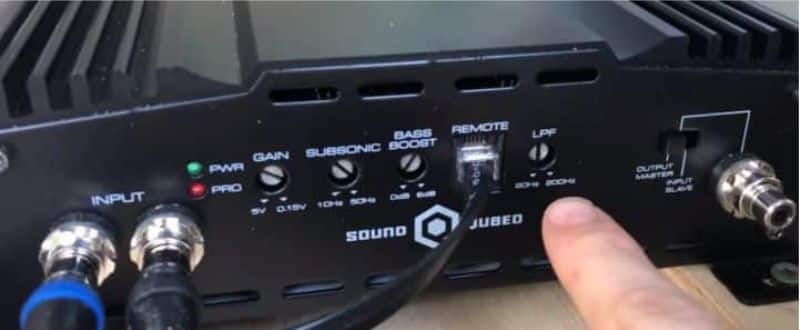Are you looking for a way to make your audio sound like you’re right there in the studio? Rev up your car's audio experience by effortlessly adjusting the low-pass filter on your subwoofer—just turn the dial or tweak the setting in your stereo's menu to only let those deep, ground-shaking bass tones through for the smoothest blend with your car's speakers!
To make the process easier, I have prepared this simple step-by-step guide on how to set low pass filter on subwoofer to help you out. But first, let's try to understand how the low-pass filter functions.
In This Article
What Is a Low-Pass Filter Anyway?
The low-pass filter adjusts which frequencies your subwoofer will reproduce, blocking higher frequencies and allowing only the lower frequencies to pass through. This makes your music sound cleaner because each part of your car's audio system does what it does best. Now, I will be looking into the process.
Step-by-Step Guide for Setting Subwoofer's Low-Pass Filter
Have a look at my easy 3-step guide, which will lead your car’s audio system to have the perfect bass.
Step 1: Determining the Frequency Range
Generally, for full-range subwoofers that offer a broad frequency response, I recommend setting the LPF around 80 Hz to ensure the subwoofer handles only the low frequencies it's best at producing.
However, if your speakers have a more limited frequency range and cannot reproduce sounds below a certain threshold—say, 50 Hz—it's advisable to adjust the LPF to match this lower limit, effectively setting it at or below 50 Hz to complement the speakers' capabilities. Most times, setting your subwoofer's low-pass filter (LPF) to around 70 to 80 Hz is a good bet.
This information is usually found in the subwoofer's manual or manufacturer's website. Knowing this will help you set the appropriate LPF to ensure your subwoofer operates within its optimal range. This setting helps to keep the bass sounding smooth and pure without any higher-pitch noises jumping in. If it sounds too low, you might need to turn up the subwoofer's power a bit.
Step 2: Tuning to Perfection
After figuring out the best frequency for your music, it's time to adjust the "Low Pass Filter" or "Crossover" knob on your subwoofer. This knob lets you decide which low sounds (like the deep booms in music) your subwoofer plays.
Turn this knob to the frequency you chose so your subwoofer plays sound only below this level, and the higher sounds (like vocals or guitars) go to the other speakers.
Be careful not to turn it up too high so you don't break your subwoofer. Once you set it around the right area, play your favorite songs and listen carefully. Adjust the LPF slowly to find that sweet spot where the bass feels just right—strong and clear without any higher frequency sounds muddling it up.
Step 3: Fine-Tuning for the Room
After choosing the perfect kind of LPF, don't forget the size and shape of your car (yes, it's kind of like a room!) can affect how sound waves bounce around and how the bass feels. You might need to play around with the LPF settings a bit to get everything sounding just right in your specific vehicle.
Bonus Tip: Matching Your System
If you're a tech wizard, you might even consider the specific type of low-pass filter. Selecting the right Low Pass Filter (LPF) type can make a big difference in how your music sounds. Here's a brief guide on some LPF types to help you choose:
- Active Low Pass Filter: This type uses an amplifier to enhance the desired low frequencies while cutting out the highs, leading to a cleaner sound with less distortion.
- Passive Low Pass Filter: This simpler filter uses components like resistors and capacitors to let low sounds through while blocking high ones, perfect for a straightforward setup.
- Elliptic Filter: Combines sharp roll-off rates with minimal passband ripples, making it useful in scenarios requiring both high attenuation of unwanted frequencies and low distortion within the desired frequency range, such as in advanced car audio setups.
- Butterworth Filter: Known for its flat response within the bass range, it ensures smooth transitions between sounds with a consistent -20dB per decade roll-off.
- Chebyshev Filter: If you need a sharp cut between your bass and the rest, a Chebyshev filter does just that, although it might introduce some ripples in your sound.
- Bessel Filter: For the purest sound without distortion, the Bessel filter maintains a linear phase response, keeping your music clear and true to its original form.
Final Words
Usually, you go with the default sound given to your sub, not knowing that the bass can be made much better simply by setting the LPF for your sub.
But now you know the way! Start with the recommended settings, then adjust to your taste and your car's specific acoustics. And if you're naturally into tweaking things, diving into the types of low-pass filters and understanding your system's specs can make your bass even better.
With a bit of patience and experimentation, you'll set the stage for audio excellence that makes every drive a pleasure.
My passion for automotive mechanics began in my father’s garage. Today, I co-own a local car service agency and write for CarAudioHunt to help readers with car audio and vehicle upgrades. With years of hands-on experience, I offer expert guidance for both DIY enthusiasts and beginners.
